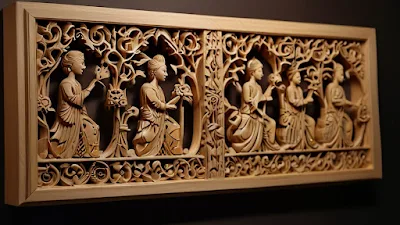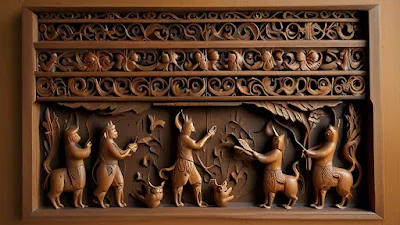A Step-by-Step Guide to Creating Stunning Woodcarvings
Note: This article is a comprehensive guide for beginners and enthusiasts who are interested in learning the art of woodcarving. Whether you are a novice or have some experience, this step-by-step guide will provide you with the knowledge and techniques to create stunning woodcarvings.
Introduction to Woodcarving
Woodcarving is an ancient art form that has been practised for centuries. It involves shaping and sculpting wood to create intricate designs and detailed sculptures. Woodcarving can be a rewarding and fulfilling hobby, allowing you to express your creativity and create beautiful pieces of art.
To get started with woodcarving, you will need some basic tools and materials. These include carving knives, chisels, gouges, mallets, and sandpaper. Additionally, you will need a workbench or carving station, protective gear such as gloves and goggles, and a variety of wood blanks to practice on.
Tools and Materials Needed for Woodcarving
When it comes to woodcarving, having the right tools and materials is essential. Carving knives are the most basic tool you will need, and they come in various shapes and sizes. Chisels and gouges are used for removing larger portions of wood and creating intricate details. Mallets are used to strike the carving tools, providing the necessary force to remove wood.
In addition to the carving tools, you will need a workbench or carving station to secure your wood blank while you work. This will ensure stability and prevent accidents. You should also invest in protective gear such as gloves to protect your hands from accidental cuts and goggles to protect your eyes from flying wood chips.
Lastly, you will need a variety of wood blanks to practice on. Different types of wood have different characteristics and are suited for different types of carving. Some popular choices include basswood, butternut, and mahogany. Experimenting with different types of wood will help you understand their unique properties and how they affect your carving.
Different Types of Wood for Woodcarving
Choosing the right wood for your woodcarving project is crucial. Different types of wood have different characteristics that can affect your carving technique and the final appearance of your woodcarving. Here are some commonly used woods for woodcarving:
Basswood: Basswood is a softwood that is easy to carve and has a fine, even grain. It is a popular choice for beginners due to its forgiving nature and availability.
Butternut: Butternut is a hardwood that is relatively easy to carve. It has a beautiful grain pattern and a warm, golden-brown colour. Butternut is commonly used for carving decorative pieces and furniture.
Mahogany: Mahogany is a hardwood known for its durability and rich, reddish-brown colour. It is a versatile wood that can be carved into intricate designs and is often used for creating fine furniture and decorative items.
These are just a few examples of the many types of wood available for woodcarving. Each wood has its own unique characteristics, so it's important to experiment and find the ones that suit your style and preferences.
Basic Woodcarving Techniques
Before diving into the step-by-step process of woodcarving, it's important to familiarize yourself with some basic techniques. These techniques will serve as a foundation for your woodcarving journey and help you create clean and precise cuts.
One of the most essential techniques is the push cut. This involves pushing the carving tool away from you, using your body's weight and controlled movements to remove wood. It's important to maintain a steady and controlled grip on the tool to ensure accuracy.
Another important technique is the stop cut. This involves making a perpendicular cut to create a defined boundary or stop point. It helps in creating sharp edges and separating different sections of your design.
Additionally, understanding grain direction is crucial in woodcarving. The grain refers to the direction in which the wood fibres run. Carving against the grain can lead to splintering and rough cuts while carving with the grain allows for smoother cuts and better control.
By mastering these basic techniques, you will be well-prepared to tackle more complex woodcarving projects and create stunning woodcarvings.
Step-by-Step Guide to Carving a Simple Design
Now that you have a good understanding of the tools and techniques involved in woodcarving, let's dive into a step-by-step guide to carving a simple design. This will help you practice your skills and gain confidence in your abilities.
Choose a wood blank: Start by selecting a suitable wood blank for your design. Consider the size, grain pattern, and type of wood that would work best for your project.
Sketch your design: Use a pencil to sketch your design directly onto the wood blank. This will serve as a guide for your carving.
Rough shaping: Begin by removing excess wood around your design using a carving knife or chisel. This will help you establish the basic shape and proportions of your carving.
Refine the details: Use smaller carving tools to refine the details of your design. Pay attention to the curves, angles, and textures to bring your design to life.
Sanding and finishing: Once you are satisfied with the shape and details of your carving, use sandpaper to smooth out any rough edges. Apply a wood finish or sealant of your choice to protect the wood and enhance its appearance.
By following these steps, you will be able to create a simple woodcarving that showcases your skills and creativity.
Adding Detail and Texture to Your Woodcarvings
To take your woodcarvings to the next level, it's important to focus on adding detail and texture. These elements will bring depth and visual interest to your carvings, making them more visually appealing.
Detailing involves adding intricate features such as facial expressions, patterns, or textures to your woodcarvings. This can be achieved using smaller carving tools and techniques such as chip carving or relief carving. Take your time and pay attention to the small details that will make your woodcarving stand out.
Texture, on the other hand, refers to the surface quality of your woodcarving. This can be achieved by using different carving techniques such as gouging, stippling, or sanding. Experiment with different tools and techniques to create various textures that complement your design.
By combining detail and texture, you can create stunning woodcarvings that capture the attention of viewers and showcase your craftsmanship.
Finishing and Preserving Your Woodcarvings
Once you have completed your woodcarving, it's important to apply a suitable finish or sealant to protect the wood and enhance its appearance. There are various options available, depending on the desired look and level of protection.
One popular choice is a clear varnish or lacquer, which provides a glossy finish and protects the wood from moisture and UV damage. Another option is to use wood oils, such as linseed oil or tung oil, which penetrate the wood fibres and enhance the natural beauty of the wood. Be sure to follow the manufacturer's instructions for application and drying times.
Additionally, proper storage and maintenance are essential for preserving your woodcarvings. Avoid exposing them to direct sunlight or extreme temperature changes, as this can cause the wood to warp or crack. Regularly dust and clean your woodcarvings using a soft, dry cloth to remove any dirt or debris.
By taking these steps, you can ensure that your woodcarvings remain in pristine condition for years to come.
Advanced Woodcarving Techniques
Once you have mastered the basics of woodcarving, you may be ready to explore more advanced techniques. These techniques allow for greater intricacy and complexity in your woodcarvings, pushing the boundaries of your creativity and skill.
One advanced technique is relief carving, which involves carving away portions of the wood to create a three-dimensional design that stands out from the background. This technique requires careful planning and execution, as well as an understanding of depth and perspective.
Another advanced technique is chip carving, which involves removing small chips of wood to create intricate geometric patterns or designs. This technique requires precision and control, as each chip must be carefully carved to achieve the desired pattern.
By challenging yourself with these advanced techniques, you can continue to grow and evolve as a woodcarver, creating truly stunning and unique woodcarvings.
Showcasing and Selling Your Woodcarvings
Once you have honed your woodcarving skills and created a collection of stunning woodcarvings, you may be interested in showcasing and selling your work. Here are some tips to help you get started:
Create a portfolio: Document your woodcarvings by taking high-quality photographs that capture the details and craftsmanship. Compile these photographs into a portfolio that showcases your best work.
Participate in exhibitions and shows: Look for local art exhibitions, craft shows, or galleries where you can display and sell your woodcarvings. These events provide an opportunity to connect with potential buyers and fellow woodcarvers.
Build an online presence: Create a website or online store to showcase and sell your woodcarvings. Share your process, inspirations, and stories behind your creations. Utilize social media platforms to reach a wider audience and engage with potential customers.
Collaborate with other artists: Consider collaborating with other artists or craftsmen to create unique and collaborative pieces. This can help expand your network and attract new customers.
Remember, selling your woodcarvings requires patience, persistence, and a strong belief in the value of your work. With dedication and a strategic approach, you can turn your passion for woodcarving into a successful business.
Resources for Further Learning and Inspiration
Woodcarving is a lifelong learning journey, and there are numerous resources available to help you expand your knowledge and find inspiration. Here are a few recommended resources:
Books: There are many books dedicated to woodcarving techniques, design inspiration, and the history of woodcarving. Some popular titles include "The Complete Book of Woodcarving" by Everett Ellenwood and "Woodcarving: The Beginner's Guide" by William Wheeler.
Online tutorials and videos: Websites such as YouTube offer a wealth of free tutorials and instructional videos on woodcarving techniques. Some popular woodcarving channels include "Woodcarving Workshops" and "Wood by Wright."
Woodcarving communities and forums: Joining online communities and forums dedicated to woodcarving can provide valuable insights, feedback, and support. Websites like Woodcarving Illustrated and The Carving Path are great places to connect with fellow woodcarvers.
Workshops and classes: Consider attending workshops or classes conducted by experienced woodcarvers. These provide hands-on learning opportunities and the chance to learn from professionals in a supportive environment.
By immersing yourself in these resources, you can continue to grow and improve your woodcarving skills, staying inspired and motivated throughout your journey.
Conclusion
Woodcarving is a beautiful and timeless art form that allows you to create stunning and unique pieces of art. Whether you are a beginner or have some experience, this step-by-step guide has provided you with the knowledge and techniques to master the art of woodcarving.
Remember to start with the basics, invest in the right tools and materials, and practice your skills regularly. With time and dedication, you will develop your own style and create woodcarvings that reflect your artistic vision.
So, grab your carving tools, select a wood blank, and let your creativity flow. Explore the endless possibilities of woodcarving and create stunning woodcarvings that will be admired for generations to come.
See more in our blog: wood carving art
Disclaimer: Woodcarving involves the use of sharp tools and can be potentially dangerous. Always prioritize safety by wearing protective gear and following proper techniques. If you are a beginner, consider seeking guidance from an experienced woodcarver or taking a beginner's class to ensure safe and effective learning.


